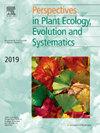An ecological and evolutionary approach to arboreal communities under different environmental stress conditions
IF 3.5
3区 环境科学与生态学
Q1 ECOLOGY
Perspectives in Plant Ecology Evolution and Systematics
Pub Date : 2024-10-09
DOI:10.1016/j.ppees.2024.125828
引用次数: 0
Abstract
Biodiversity distribution patterns and the ecological processes underlying them reflect how organisms respond to abiotic and biotic factors that interact across both space and time. In this study, we aimed to test the hypothesis that small-scale environmental variations shape ecological and phylogenetic patterns in arboreal communities through environmental filters created by the specific conditions of each environment examined. We investigated a mosaic of Atlantic forest environments, analyzing species composition, community dynamics, and phylogenetic relationships among the various environments. This approach provided valuable insight into how environmental factors influence the ecological differentiation of these communities. Variations in conditions and resources produced environmental filters that resulted in significant small-scale heterogeneity in species composition, community dynamics, and evolutionary relationships among the environments. By considering the dynamic interations between biotic and abiotic factors, we conclude that the prevailing environmental conditions at these sites play a crucial role in shaping the behavior and distribution of the species that inhabit them.
不同环境压力条件下树栖群落的生态和进化方法
生物多样性分布模式及其背后的生态过程反映了生物是如何对跨时空相互作用的非生物和生物因素做出反应的。在这项研究中,我们旨在验证一个假设,即小尺度的环境变化通过所考察的每个环境的特定条件所产生的环境过滤器来塑造树栖群落的生态和系统发育模式。我们调查了大西洋森林的各种环境,分析了各种环境中的物种组成、群落动态和系统发育关系。这种方法为我们深入了解环境因素如何影响这些群落的生态分化提供了宝贵的资料。条件和资源的变化产生了环境过滤器,导致物种组成、群落动态和环境之间的进化关系出现了显著的小范围异质性。通过考虑生物因素和非生物因素之间的动态相互关系,我们得出结论,这些地点的主要环境条件在塑造栖息于其中的物种的行为和分布方面发挥着至关重要的作用。
本文章由计算机程序翻译,如有差异,请以英文原文为准。
求助全文
约1分钟内获得全文
求助全文
来源期刊
CiteScore
6.50
自引率
0.00%
发文量
28
审稿时长
67 days
期刊介绍:
Perspectives in Plant Ecology, Evolution and Systematics (PPEES) publishes outstanding and thought-provoking articles of general interest to an international readership in the fields of plant ecology, evolution and systematics. Of particular interest are longer, in-depth articles that provide a broad understanding of key topics in the field. There are six issues per year.
The following types of article will be considered:
Full length reviews
Essay reviews
Longer research articles
Meta-analyses
Foundational methodological or empirical papers from large consortia or long-term ecological research sites (LTER).

 求助内容:
求助内容: 应助结果提醒方式:
应助结果提醒方式:


